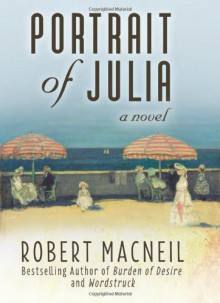
For those of us who read Robert MacNeil's debut novel, "BURDEN OF DESIRE" (and LOVED it as I did), the young war widow Julia Robertson returns in this novel. The year is 1919. The First World War has ended and Canada has gained from it a greater sense of itself, having sacrificed 67,000 men in battle, or roughly 10% of the total number of Canadians who were mobilized. Julia has largely come to terms with her husband's death 2 years earlier. But she's not quite sure what she wants to do with her life. Living in Halifax (Nova Scotia) with its social code a carryover from Victorian times is stultifying and stifling for her. Julia feels herself a modern woman with wide-ranging interests in the arts, literature, and psychology (in particular, the Jungian and Freudian Schools). She is, at 28, a deeply passionate woman, and has struck up a special friendship with Stewart MacPherson, who was last seen in "Burden of Desire." He is a professor of psychology at Dalhousie University and one of the pioneer exponents of Freudian psychoanalysis in Halifax, offering specialized therapy to returning veterans suffering from shell-shock.
Much as Julia enjoys Stewart's company and the times they have spent together since becoming acquainted in the aftermath of the tragic Halifax Explosion, which devastated a significant part of the city in December 1917, she does not feel what she would consider as love for him. Their relationship, which on the surface is platonic, has also had its hotly passionate moments, which both have taken pains to keep discreet from family and friends. Their relationship undergoes a subtle change when Julia receives in the spring a letter from a British naval officer (Neville Boiscoyne) she had briefly met at a party several weeks after learning of her husband's death. Neville, acting as equerry to the Prince of Wales, would be returning to Canada that August (1919) as part of a tour the Prince was making to various parts of the Empire. Julia finds herself thrilled at the thought of seeing Neville again and becoming better acquainted. There was, she had to admit to herself, a warm and magnetic attraction she felt that also stirred deep, sexual yearnings for him. (And Neville felt the same way about Julia.)
MacNeil also has shifts in time and place to illustrate certain crucial experiences in Julia's life that cause her to make some major life changes. These shifts sometimes take place within a chapter or across different chapters. For instance, there are scenes between Julia and her former sister-in-law Lucy that are really endearing, because from their dialogue, it becomes abundantly clear how well they get along with each other and freely share confidences. (Lucy's husband Harry, in contrast to Julia's, rose to high rank during the war and survived combat without a scratch. His record was so outstanding that he was appointed as an aide to the Canadian Prime Minister during the Paris Peace Conference. Indeed, it was Harry who was able to wrangle invitations for Lucy, Julia, Stewart, the local Anglican priest Peter Wentworth (with whom Julia had an unwanted and embarrassing encounter in "Burden of Desire) and his wife Margery (who craves to be the center of attention) to have dinner with the Prince and Neville aboard the ship HMS Renown.) There are also scenes of the subsequent journey Julia makes to Britain (where she meets Neville's family) and France (where she renews her acquaintance with the painter J.W. Morrice --- a real-life Canadian painter of some distinction living on the Côte d'Azur --- for whom she poses for a painting early in 1920).
There are also a lot of "juicy bits" and surprises that take place in the novel. In fact, the ending came as a complete surprise to me. But I leave it to you, reader of this review, to read "PORTRAIT OF JULIA" for yourself, so that you can savor and enjoy this richly nuanced novel. [However if you're really keen on knowing the particulars about Julia Robertson, read "BURDEN OF DESIRE" first.]


 Log in with Facebook
Log in with Facebook 







